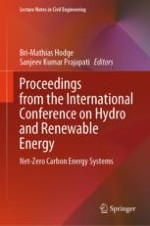2024 | OriginalPaper | Buchkapitel
Indirect Forecasting of Hourly PV Power Generation Based on a Hybrid Model Combining Data Analysis and Machine Learning Technique
verfasst von : Priya Gupta, Rhythm Singh
Erschienen in: Proceedings from the International Conference on Hydro and Renewable Energy
Verlag: Springer Nature Singapore
Aktivieren Sie unsere intelligente Suche, um passende Fachinhalte oder Patente zu finden.
Wählen Sie Textabschnitte aus um mit Künstlicher Intelligenz passenden Patente zu finden. powered by
Markieren Sie Textabschnitte, um KI-gestützt weitere passende Inhalte zu finden. powered by
